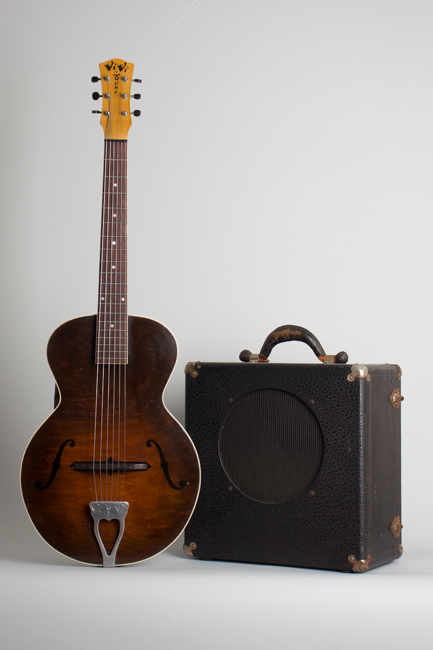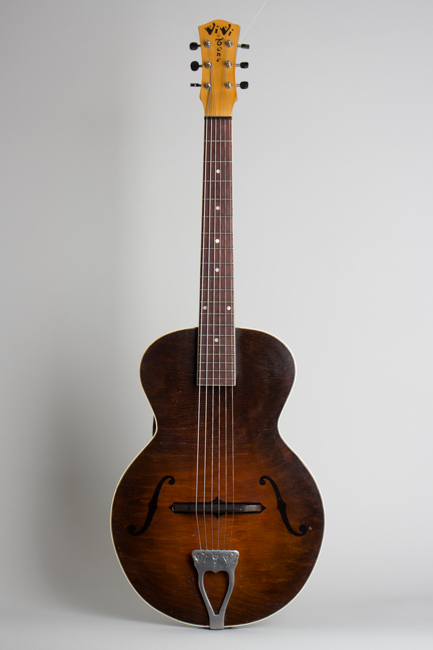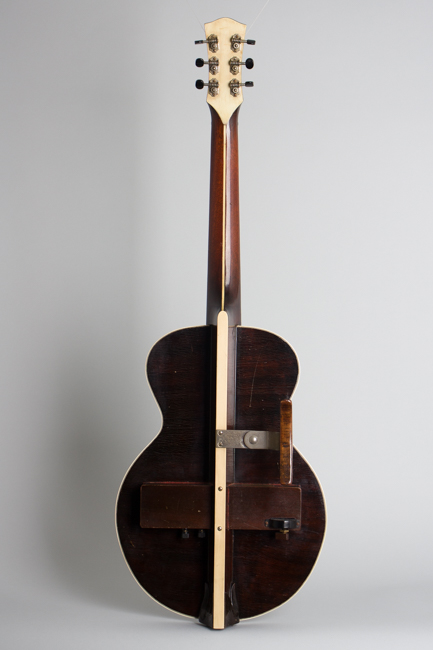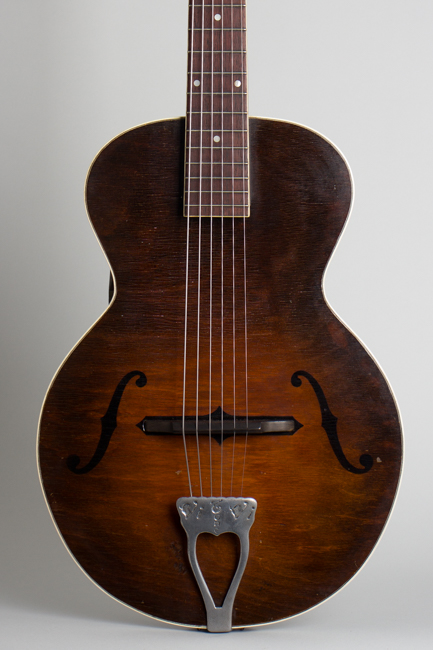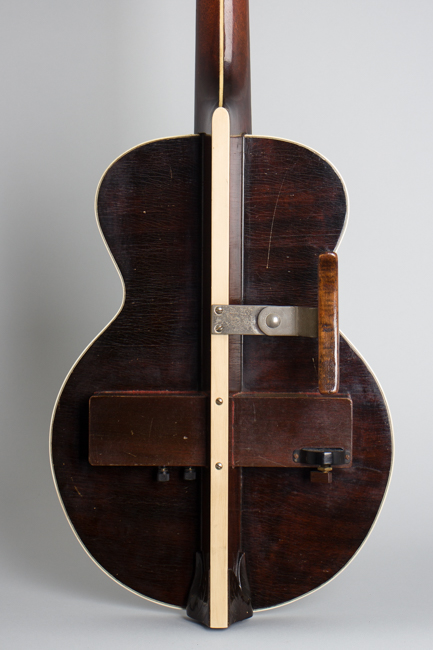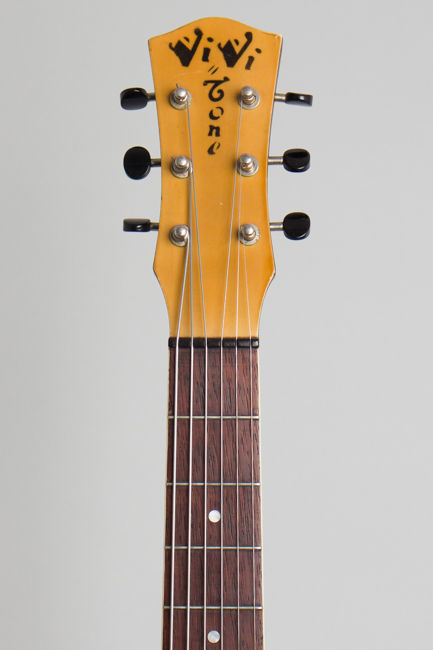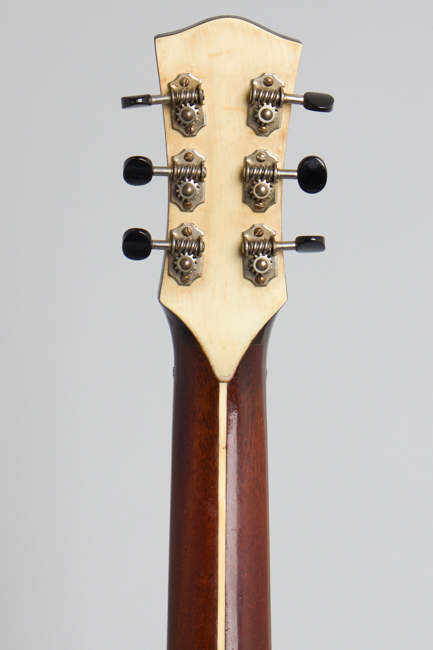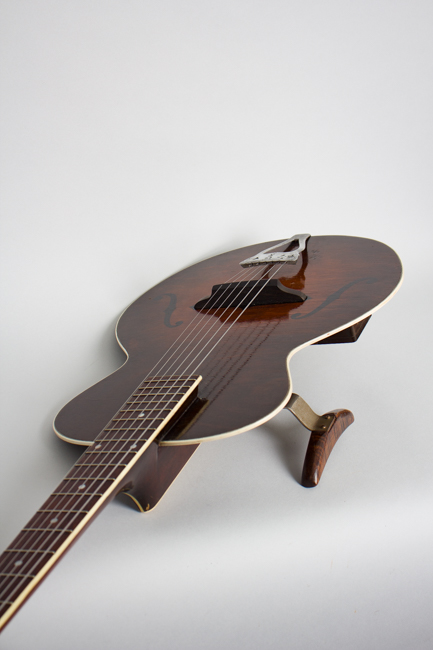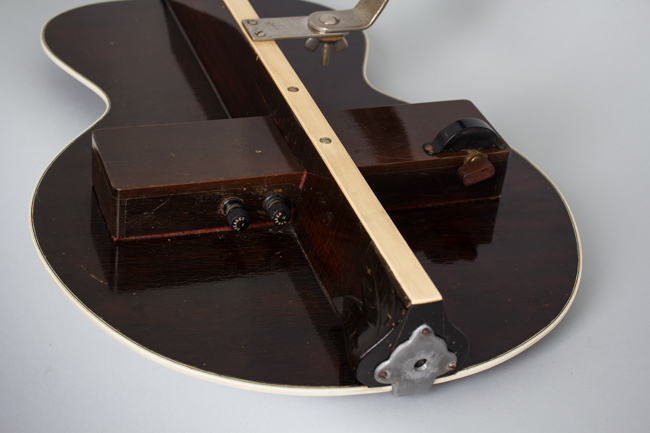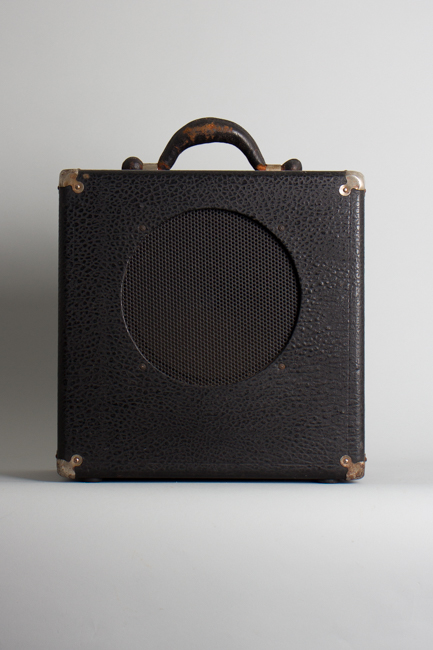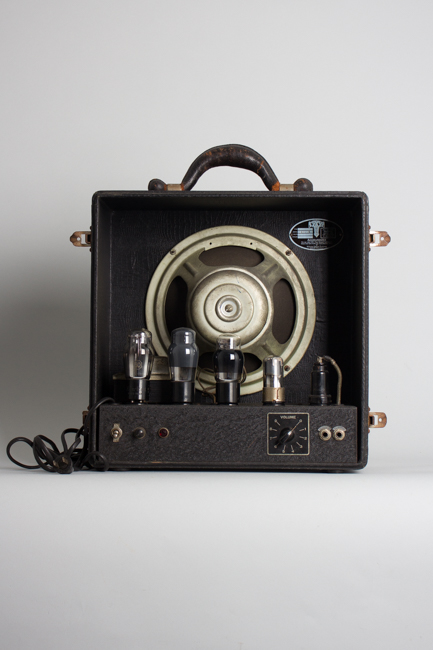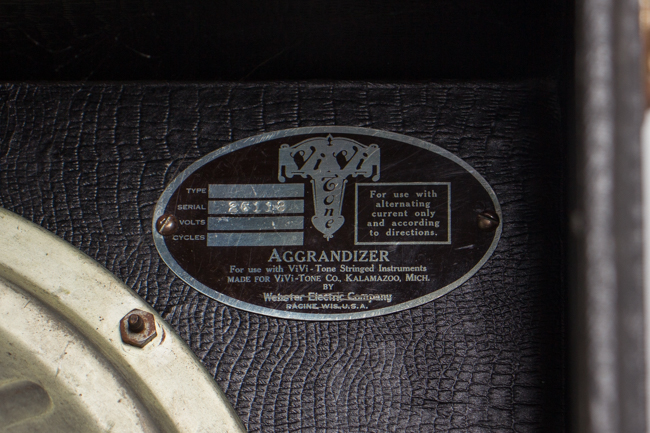Vivi-Tone with Amplifier Solid Body Electric Guitar (1932)
This item is currently on hold.
Item # 11430
Prices subject to change without notice.
Vivi-Tone with Amplifier Model Solid Body Electric Guitar (1932), made in Kalamazoo, Michigan, serial # 47, dark brown sunburst lacquer finish, Mahogany centerpiece, maple body cap; laminated mahogany neck with ebony fingerboard., tweed hard shell case.
This instrument is a true museum piece, one of the rarest and most historically interesting guitars ever made. Designed by ex-Gibson "Master" Lloyd Loar and partner (at Gibson and beyond) Lewis A. Williams, this Vivi-Tone Electric is THE earliest example of a solid body electric guitar. Research indicates this solid "plank" body Vivi-Tone, built around mid-1932 is the first commercial attempt at a guitar with no resonant chamber. Although extremely short-lived and sold in minimal quantity, this is a well thought out and beautifully made instrument and a truly unique piece of history.
Loar and Williams both left Gibson in 1923-4. By the early 1930s Williams was bullish on the future of amplification, and by 1932 Loar joined him in launching the Vivi-Tone operation. They were predated only by the lost 1929 Stromberg-Voisinet electrics, and are contemporary the earliest 1932 Rickenbacker Electro models. Loar himself primarily played violin and mandolin family instruments, so Vivi-Tone's early line comprised bowed and plucked string instruments as well as electric keyboards. Loar's stated goal was to capture "pure string tone" thus his first designs eliminated the "interfering" resonance of an acoustic body. These "skeleton" instruments were the first Vivi-Tone products, promoted in a brochure issued by August 1932.
This instrument bears a hand-written serial #47; that series would include all types of instrument, only a small proportion being guitars. Despite its eccentric design, this is a beautifully made and playable guitar with a complex, if somewhat primitive, pickup design. The solid "body" consists of a 19" long 2 1/4" deep piece of mahogany, to which the neck is attached. This core is tapered front to back (following the neck heel) and capped on the back in ivoroid. The back end mounts the tailpiece and has a carved oak leaf design; it may have been a commercial furniture blank intended for use as a table leg! The guitar "body" is a flat plate of maple 3/16" thick, triple bound on the edges and decorated with painted f-holes. The subtle hand-rubbed sunburst on the top is similar to 1920s Loar-era "Cremona Brown" Gibson finishes. A piece of 1920s Ludwig-marked drum hardware has been adapted (at the factory?) to help space the guitar off the player's body.
The neck is mahogany with an ivoroid center strip shaped to a "V" profile. The bound ebony fingerboard has pearl dot inlay. The headstock is veneered front and back with ivoroid, with a screened Art Nouveau Vivi-Tone logo on the face. The tuners are individual riveted plastic button Grovers. The unique tailpiece is cast manganese with an impressed Vivi-Tone logo, which has a hole for an endpin although none was ever fitted to the instrument. The bridge is a single carved piece of ebony, which mounts through a black-edged slot in the body to connect to the pickup apparatus underneath. The instrument is quite elegant in appearance, from the front anyway!
The pickup is enclosed in a wooden box under the bridge which also carries the lever-activated volume control and screw terminal connectors. Loar's pickup design is a hybrid magnetic/electrostatic type with vibration from the wooden bridge activating a metal plate sensed by the magnetic coil beneath. This is not as effective as the horseshoe magnet design pioneered by Rickenbacker at the same time, but is fully functional. Instead of a jack there are two terminals marked "Speaker+ and "Speaker-" to which the cable must be hand-wired before connecting to an amp!
This guitar was built at the latest in the summer of 1932, possibly months earlier than that. By that fall Vivi-Tone abandoned this design, re-thinking their guitars into more familiar (but still rare) Acoustic-electric instruments launched in 1933. In the thin depression years the company never prospered, with no more than 600 total instruments of all styles produced into the mid-30s. No more than 96 total Vivi-tone instruments of all types of this "plank" design are thought to have been produced, with only a small proportion being guitars.
Today just a handful of these "Skeleton" Vivi-Tone guitars are documented to exist. In 1932 Hawaiian guitars were the primary focus at Rickenbacker, and their few earliest Standard models were built with a hollow body. This Vivi-Tone guitar stands as the earliest commercially produced solid body guitar, the very beginnings of where the guitar would go over the next century. This historic piece is accompanied with a period Vivi-tone "Aggrandizer" amplifier, likely built around 1933-4 to complete the set. The guitar is fully functional and playable, the amplifier is not but can be restored if desired.
Overall length is 37 7/8 in. (96.2 cm.), 13 7/16 in. (34.1 cm.) wide at lower bout, and 2 7/16 in. (6.2 cm.) in depth at deepest point. Scale length is 24 1/4 in. (616 mm.).
This 90-year-old guitar is an amazing survivor, fully original and in excellent playable condition. The finish shows moderate checking on the "plank" body and minor wear overall with some dings, dents and scrapes. The only serious loss is one area above the tailpiece that had some larger dings, somewhat heavily touched up long ago. Perhaps someone used a "dog clip' strap there. The headstock veneer has darkened somewhat over time and a couple of corner tips are very slightly curled.
The neck is quite straight, the frets in excellent shape and the guitar plays nicely. The sound is of course somewhat microphonic, put has a stronger output than some Vivi-Tones we have had (and we've had more than most!) and can be quite pleasing even considering the limitations. There is a cord provided that allows easy connection from the terminals on the guitar to any phone plug amp input.
The original 1932-34 Vivi-Tone "Aggrandizer" amplifier paired with this guitar is not currently functional; to preserve its original state no electronic repairs have been effected. It can be made functional by the replacement of some of the antiquated components if desired, but considering its historical importance we have left it in unaltered original condition. Cosmetically it is excellent with some typical minor external wear. This set truly represents the earliest beginnings of the amplified guitar, the very first solid body electric. It is genuine museum piece worthy of any collection of 20th century instruments. Excellent - Condition.
This instrument is a true museum piece, one of the rarest and most historically interesting guitars ever made. Designed by ex-Gibson "Master" Lloyd Loar and partner (at Gibson and beyond) Lewis A. Williams, this Vivi-Tone Electric is THE earliest example of a solid body electric guitar. Research indicates this solid "plank" body Vivi-Tone, built around mid-1932 is the first commercial attempt at a guitar with no resonant chamber. Although extremely short-lived and sold in minimal quantity, this is a well thought out and beautifully made instrument and a truly unique piece of history.
Loar and Williams both left Gibson in 1923-4. By the early 1930s Williams was bullish on the future of amplification, and by 1932 Loar joined him in launching the Vivi-Tone operation. They were predated only by the lost 1929 Stromberg-Voisinet electrics, and are contemporary the earliest 1932 Rickenbacker Electro models. Loar himself primarily played violin and mandolin family instruments, so Vivi-Tone's early line comprised bowed and plucked string instruments as well as electric keyboards. Loar's stated goal was to capture "pure string tone" thus his first designs eliminated the "interfering" resonance of an acoustic body. These "skeleton" instruments were the first Vivi-Tone products, promoted in a brochure issued by August 1932.
This instrument bears a hand-written serial #47; that series would include all types of instrument, only a small proportion being guitars. Despite its eccentric design, this is a beautifully made and playable guitar with a complex, if somewhat primitive, pickup design. The solid "body" consists of a 19" long 2 1/4" deep piece of mahogany, to which the neck is attached. This core is tapered front to back (following the neck heel) and capped on the back in ivoroid. The back end mounts the tailpiece and has a carved oak leaf design; it may have been a commercial furniture blank intended for use as a table leg! The guitar "body" is a flat plate of maple 3/16" thick, triple bound on the edges and decorated with painted f-holes. The subtle hand-rubbed sunburst on the top is similar to 1920s Loar-era "Cremona Brown" Gibson finishes. A piece of 1920s Ludwig-marked drum hardware has been adapted (at the factory?) to help space the guitar off the player's body.
The neck is mahogany with an ivoroid center strip shaped to a "V" profile. The bound ebony fingerboard has pearl dot inlay. The headstock is veneered front and back with ivoroid, with a screened Art Nouveau Vivi-Tone logo on the face. The tuners are individual riveted plastic button Grovers. The unique tailpiece is cast manganese with an impressed Vivi-Tone logo, which has a hole for an endpin although none was ever fitted to the instrument. The bridge is a single carved piece of ebony, which mounts through a black-edged slot in the body to connect to the pickup apparatus underneath. The instrument is quite elegant in appearance, from the front anyway!
The pickup is enclosed in a wooden box under the bridge which also carries the lever-activated volume control and screw terminal connectors. Loar's pickup design is a hybrid magnetic/electrostatic type with vibration from the wooden bridge activating a metal plate sensed by the magnetic coil beneath. This is not as effective as the horseshoe magnet design pioneered by Rickenbacker at the same time, but is fully functional. Instead of a jack there are two terminals marked "Speaker+ and "Speaker-" to which the cable must be hand-wired before connecting to an amp!
This guitar was built at the latest in the summer of 1932, possibly months earlier than that. By that fall Vivi-Tone abandoned this design, re-thinking their guitars into more familiar (but still rare) Acoustic-electric instruments launched in 1933. In the thin depression years the company never prospered, with no more than 600 total instruments of all styles produced into the mid-30s. No more than 96 total Vivi-tone instruments of all types of this "plank" design are thought to have been produced, with only a small proportion being guitars.
Today just a handful of these "Skeleton" Vivi-Tone guitars are documented to exist. In 1932 Hawaiian guitars were the primary focus at Rickenbacker, and their few earliest Standard models were built with a hollow body. This Vivi-Tone guitar stands as the earliest commercially produced solid body guitar, the very beginnings of where the guitar would go over the next century. This historic piece is accompanied with a period Vivi-tone "Aggrandizer" amplifier, likely built around 1933-4 to complete the set. The guitar is fully functional and playable, the amplifier is not but can be restored if desired.
Overall length is 37 7/8 in. (96.2 cm.), 13 7/16 in. (34.1 cm.) wide at lower bout, and 2 7/16 in. (6.2 cm.) in depth at deepest point. Scale length is 24 1/4 in. (616 mm.).
This 90-year-old guitar is an amazing survivor, fully original and in excellent playable condition. The finish shows moderate checking on the "plank" body and minor wear overall with some dings, dents and scrapes. The only serious loss is one area above the tailpiece that had some larger dings, somewhat heavily touched up long ago. Perhaps someone used a "dog clip' strap there. The headstock veneer has darkened somewhat over time and a couple of corner tips are very slightly curled.
The neck is quite straight, the frets in excellent shape and the guitar plays nicely. The sound is of course somewhat microphonic, put has a stronger output than some Vivi-Tones we have had (and we've had more than most!) and can be quite pleasing even considering the limitations. There is a cord provided that allows easy connection from the terminals on the guitar to any phone plug amp input.
The original 1932-34 Vivi-Tone "Aggrandizer" amplifier paired with this guitar is not currently functional; to preserve its original state no electronic repairs have been effected. It can be made functional by the replacement of some of the antiquated components if desired, but considering its historical importance we have left it in unaltered original condition. Cosmetically it is excellent with some typical minor external wear. This set truly represents the earliest beginnings of the amplified guitar, the very first solid body electric. It is genuine museum piece worthy of any collection of 20th century instruments. Excellent - Condition.
